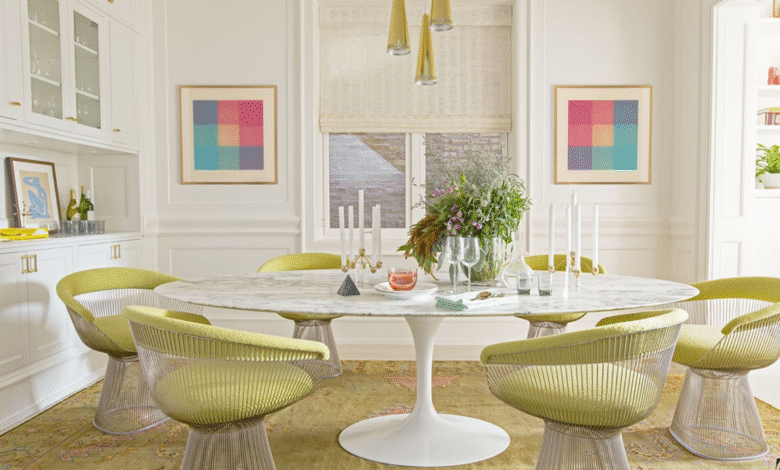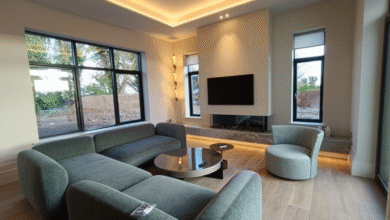Where We Gather: Rethinking the Modern Dining Room with Intention and Heart

Let’s be honest—most of us don’t use the dining room the way we used to. Once the crown jewel of formality in a home, it’s now often an afterthought. A space that holds mismatched chairs, the mail pile, maybe a treadmill. And yet, there’s something quietly sacred about the idea of gathering around a table, isn’t there? Sharing stories. Passing plates. Celebrating the everyday.
That’s why dining room design still matters—not because we need a fancy space to impress guests, but because we deserve a space that invites connection.
It’s More Than Just a Table
People often assume designing a dining room is simple: pick a table, throw in some chairs, and maybe toss a rug underneath. Done. But good design, real design, goes so much deeper than that.
It starts with questions. How do you actually use your dining room? Is it a once-a-month special-occasion space, or do you eat breakfast there every day? Do you entertain large groups, or is dinner usually a cozy meal for two? Is the room open to the kitchen, or its own separate zone?
Designing a room for your life, not someone else’s Instagram feed, is the secret sauce.
Function First, Always
Let’s be practical for a moment. There’s a flow to a good dining room. You need enough room to pull chairs back without banging into a wall. Lighting that flatters both people and plates. Surfaces that can survive spills, heat, and the occasional red wine catastrophe.
A skilled dining room designer doesn’t just think about aesthetics. They think about movement, scale, storage, and maintenance. They’ll help you choose the right materials, from scratch-resistant finishes to stain-hiding fabrics. They’ll know whether a round table or a rectangular one makes more sense, or how to visually anchor your table in an open-concept space without making it feel boxed in.
Good design feels effortless—like the space always wanted to be that way.
Atmosphere: The Underrated Ingredient
We talk a lot about decor and layout, but let’s not overlook the intangible. The vibe of a dining room might be the most important thing of all.
A well-designed dining space invites people to linger. To top off their glass and stay for another story. That might mean layered lighting (a dimmer switch is non-negotiable, trust me), warm colors, soft textures, or even something as simple as the way sound carries in the room.
Want to create a space where people feel relaxed and welcomed? Skip the stiff formality. You don’t need everything to match or feel “perfect.” What you want is harmony—between comfort and beauty, tradition and personality.
And that’s where real dining room interior design makes its mark.
Design Around the People, Not the Furniture
One of the biggest mistakes people make? Designing around the stuff instead of the people. We fixate on what shape the table should be or what kind of chandelier is in style this season, but forget to ask: Who’s sitting here? What matters to them?
If your kids do homework at the table, maybe skip the delicate chairs. If your dining room doubles as a home office, let’s find storage that blends in beautifully. If your weekly dinner parties are legendary, well—you need a layout that supports laughter and movement, not something that forces people into rigid seating.
When the space reflects your lifestyle, it becomes part of your rhythm. It’s not just a room. It’s a backdrop to your life.
The Minneapolis Factor (Or Wherever You Call Home)
If you’re in Minneapolis—or anywhere with distinct seasons—you know the way light changes throughout the year. The sun slants differently in December than it does in July. A smart designer considers that. They’ll help you make the most of your natural light, choose paint colors that don’t go cold in winter, and integrate cozy, tactile elements that make the space feel inviting year-round.
Local designers, especially those who understand regional architecture and climate, bring something extra to the table (pun intended). They know which materials hold up, how to insulate against long winters, and where to source statement pieces that support local craftsmanship.
Small Changes, Big Impact
You don’t need to gut your space or spend a fortune to upgrade your dining experience. Sometimes, all it takes is a new lighting fixture. Or replacing bulky chairs with ones that breathe. Maybe it’s a bold rug that defines the space, or wall art that tells your story.
Design isn’t just about grand gestures. It’s about alignment. The right tweak at the right time can transform a “meh” room into a space you love being in.
And if you’re starting fresh or feeling stuck? Don’t be afraid to reach out to someone who lives and breathes this stuff. A pro can see potential where you only see frustration.
Here’s your organic keyword drop, blended as naturally as possible: A thoughtful dining room design, dining room interior design, dining room designer experience brings the soul back into the space—by tuning into how you live, what you love, and how you want to feel when you sit down to eat.
Final Thought: Bring Back the Table
In a world that moves fast and often encourages us to eat alone, on the couch, with one eye on our phones, there’s something quietly radical about creating a space for togetherness. A space that says, “Sit. Stay a while.”
That’s what good dining room design is all about. It’s not about impressing your in-laws or replicating some perfect showroom. It’s about making room—for joy, for stories, for the simple, grounding act of gathering.
So light the candles. Add the mismatched plates if you love them. Let your dining room feel like an invitation to slow down. Because in the end, that’s what we all really crave—a place at the table, and a reason to stay.




